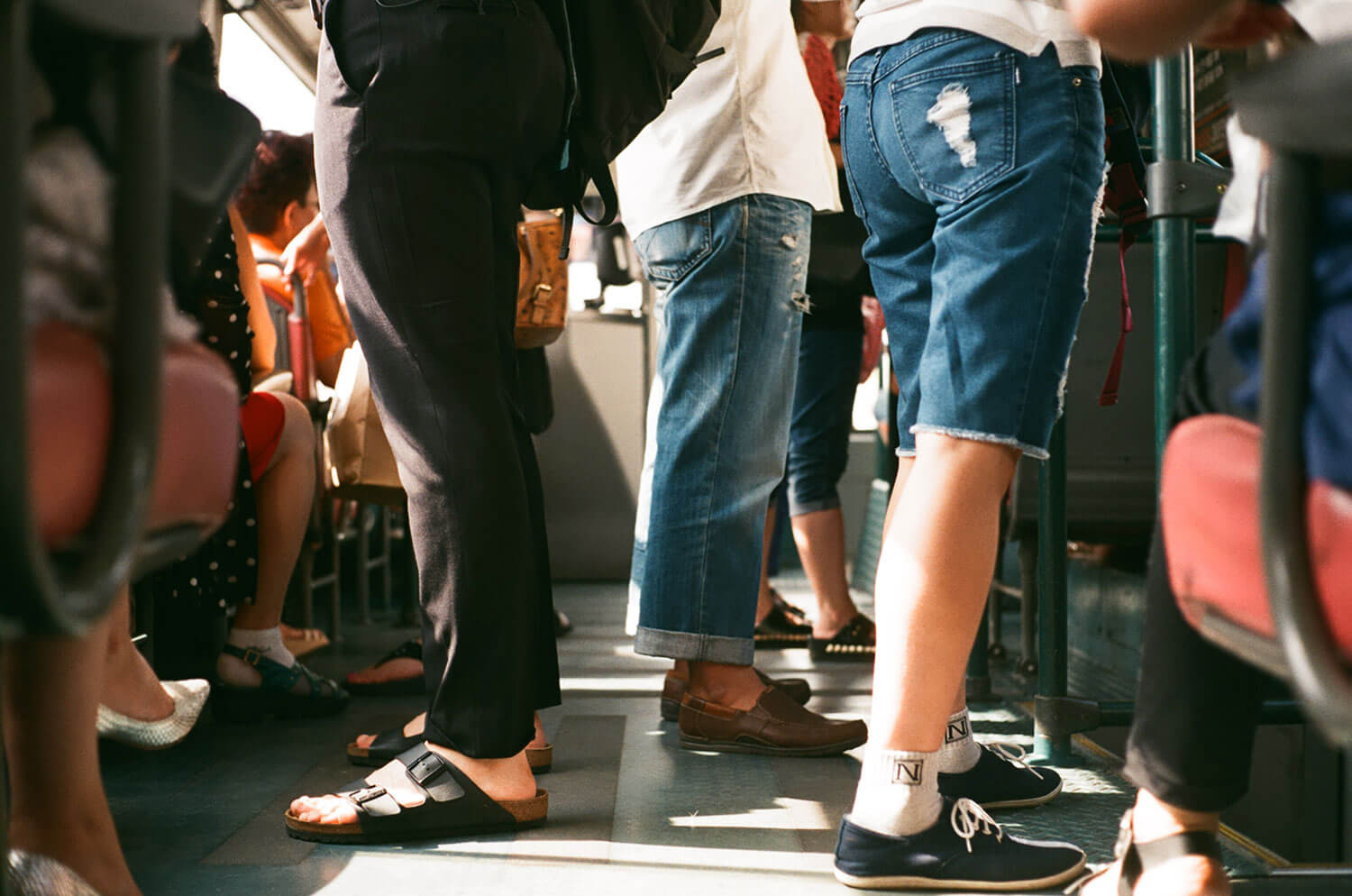
The word “neighbor” has never been an easy one to define. Unlike kinship or community ties that cohere around shared interests, motives, or loyalties, a neighbor holds no obvious commonalities with me, save trash days and wayward fruit branches on my side of the wall. In the eight years I’ve lived on Stuart Street in Berkeley, I don’t remember talking to my neighbors much — two elderly ladies downstairs with their many cats and the unit next to us a motley group of Cal students rotating in and out. We occupy the same building separated by walls, floors, cares. A good neighbor is a quiet neighbor and that’s fine by me. Especially in the Bay Area, space is practically ephemeral if you haven’t lived here for generations. Neighborhoods and populations change so quickly due to gentrification, the draw of the tech industry, and skyrocketing housing costs. Why invest in relationships (if you could even call it that) based on so transient a thing as shared space?
The peninsula across the Pacific remembered me.
Seoul, though, disagreed.
Of course, the Korea I remembered of the 80s and 90s had moved on. At the beginning of 1998 when my family left, Seoul had barely started shaking off the past century of poverty and colonization and was exercising the country’s newfound purchasing power. But despite the concrete jungle that had sprung up all around my childhood streets, upon my return in the fall of 2018, an immediate sense of home surrounded me, and I was reminded without a shadow of a doubt that I belonged here in this land. I came back, not so much as a gyopo(1) looking to “find her roots” but as one of Korea’s own, dressed differently yet fluent in our mother tongue. I moved easily in and out of a crowd, simply a face among the millions of commuters on subway line 3, becoming a part of the nebulous mass flowing through the labyrinth of Seoul’s underground transfer stations. Over the months, I settled into a mundane and comfortable routine of work and hweshik,(2) weekend outings, and study sessions. Then COVID happened.

Nothing actually seemed too different. None of the cafes, restaurants, and shops I had frequented closed down; churches and gyms eventually did shut their doors, but I never went very religiously to begin with; my work hours in the private English education industry had turned me into a night owl; and my master’s program was online in another time zone, keeping me glued to the screen and on takeout diets. I was living what the journalist Ann Babe called a honjok life sans a strict no-contact or anti-marriage principle.(3) It was a challenge for me to explain to those overseas that Korea was doing fine while also trying to imagine what shelter-in-place would even look like here. I listened to my U.S. friends’ sense of isolation and loneliness, and in turn, described to them my everyday interactions with the baristas on my street, my downstairs wine bar owner, and the kimbap lady by my work. Korean transactions seemed to happen not based on cash but on credit. And it wasn’t the plastic kind.
You live in the neighborhood? Discount.
I’ve seen you here before! Latte on the house.
No cash right now? Just pay the next time you come.
I told them how I kept finding myself in what would be considered private spaces by the North American standard: a family luncheon for a coworker’s son’s dol,(4) the annual kimchi-making weekend at an elementary friend’s dad’s country house with the in-laws, the backseat of a car of a real estate agent showing around a roommate who asked me for money for her security deposit. Like that story of the widow whose jug of oil and sack of flour did not run out during a famine,(5) jars and Ziploc bags of kimchi from five different families I had never met kept filling my fridge.
At first, I couldn’t name what it was that I was noticing, because English does not have a word for it. These folks didn’t think of me as friends, they didn’t belong to my church community, they didn’t have anything in common with each other, and they certainly weren’t family. Neighboring was the closest concept I could use to explain to those back in the States that these generous interactions were enabled by shared physical space. And this wasn’t the first time I’ve watched the principle at work.
Where everyone is someone’s uncle
I had seen how physical presence shaped my own lived reality. Every “aunt” and her daughters had watched my brother and I; we played with all kinds of kids on the streets of our parents’ church building; whoever we happened to be with around a mealtime automatically joined one. Even after decades of trying to organize and practice community on another continent (and feeling like it was a lost cause), those early memories had survived. When I imagine what the Kingdom of God looks like, I had counted on that boundary-less closeness I’d experienced as a child as a solid piece of the puzzle, but it was a piece that never fit in white spaces.(6)
These over-the-top acts of neighboring in Seoul, by people who would be strangers in any other context, weren’t driven by any utilitarian or ideological function. They didn’t demand that I somehow prove my belonging first before intruding into my life in ways usually reserved for intimate relationships. Physical presence, shared space, and bodies in close proximity engendered relationships in a way that confessions, interests, and political parties couldn’t manufacture on American soil.(7) Clearly, even in the midst of the pandemic and rise of honjok culture — or because of them — being near another person demanded attention. It required no abstract ideal about class solidarity or imago Dei. Treating a stranger like this looked downright risky to my U.S.-bred sensibilities; people were irresponsibly and wastefully throwing around jeong(8) to those unknown and unproven, with so flimsy of a tie as “you’re here”, and with absolutely zero boundaries. I had to ask: Could Korean-inspired neighboring happen outside a homogenous urban density, closing the felt and physical distance between people?
An ongoing experiment
I flew from South Korea to Los Angeles this past June and turned my question toward this gentrifying city with no real public transit and violent racial histories. Of all the U.S. metropolitan centers, Los Angeles seemed the furthest from knowing the Korean art of sharing space as sharing life. But the collective experience of this pandemic had taken on an unexpected turn. After two weeks of self-quarantine at my parents’ home in Koreatown, I finally escaped for an evening stroll between Wilton and Plymouth. I saw a row of quiet and beautiful houses that spoke of old money. Sidewalks lined with those giant palm trees I had missed so much. A passing jogger or a lady walking her puppy. These had remained the same. Except the jogger and the lady had brought their moms out.
I had never seen Angelenos walking, not like this. Three generations of an entire Spanish-speaking family speed-walked while sporting mismatching masks and a slung baby. An elderly couple held hands in silence. A threesome of obnoxiously loud Korean ahjumas decked out in their visors, face shields, and fanny packs chattered on. College-aged boys ran topless and maskless. Ladies in fashionable hijabs. Black kids on scooters. People recognizing friends and calling out to each other across the street. Palpable, physical, present. Neighboring 1.0?
I’m not saying block parties will defeat the white supremacy that is built into the very streets we walk. I’m aware of the implied ethnocentrism and its problems within my experience of neighboring in Korea. But a practice of attending to shared bodily presence has shown itself to be more powerful of a solidarity tool than I had dismissed it to be. My evening stroll is becoming a daily ritual, similar to the way getting extra banchan from my kimbap lady had been. I look forward to experimenting with neighboring here, masks on and all, and if this makes me a bad, noisy, over-the-top neighbor, so be it.
(1) It is a Korean term for those who identify as ethnically Korean but are either born abroad or naturalize in another nation. At times, the label carries a pejorative connotation. Many second and third-generation Korean Americans I know have taken this rite of passage of visiting the motherland to learn Korean and “reconnect with their cultures” as exchange students or English teachers.
(2) It literally translates into a “corporate meal”, a company or department-wide outing, traditionally with (very) heavy drinking meant to reinforce the pecking order.
(3) See the fascinating and resonant piece on hon (alone) lifestyle here. https://restofworld.org/2020/south-korea-honjok-loneliness/
(4) A baby’s first birthday is celebrated by many family members and friends (and neighbors), typically with an extravagant meal of auspicious foods. The ceremony includes a little game in which the baby gets presented with a plethora of everyday objects representing her/his potential future. A wallet means s/he would become rich; a pen means a scholar; a spool of thread, a long life, etc.
(5) 1 Kings 17:7-16
(6) I define the term as all built-in environments, physical (e.g. grocery shops, police stations) and socioeconomic (e.g. neighborhood associations, school boards), where white supremacy is the operating norm. Examples of “neighboring” abound here, too: occasional gestures of kindness like passing out home-baked cookies or an invitation to beer pong, block parties with grills and lemonade tables out in Elmwood, along with firmly locked doors, colleagues always careful not to say too much about their finances, sex lives, or political opinions, transplants who adore the Mission and Lake Merritt but stand awkward and uncomfortable in real life by the loud, smelly, and messy “hospitality” of Cuban, Filipino, and Vietnamese families.
(7) Perhaps it’s because the land is a stolen one. While this piece is in no way able to do justice to the concept of indigenous land sovereignty and its many implications, not the least of which is spiritual and should be of great concern to those who profess Christ, I recommend reading Willie James Jennings’ “The Christian Imagination: Theology and the Origins of Race”, specifically the “White Space and Literacy” and “Conclusion” chapters.
(8) Jeong, a heartfelt affection, is practically a national phenomenon in Korea. It’s a gesture and a posture, practiced with anyone you see enough times to feel affinity toward, without the formal need to be introduced with a name, an occupation, or family ties.

Hatty Lee cut her teeth on organizing at UC Berkeley to disaggregate Asian American student data and to establish a permanent home for the Multicultural Community Center. She learned from the most amazing folks while organizing tenants in the Tenderloin for affordable housing, healthcare, and community governance. Her love for Jesus and her peoples has taken her from a full-time ministry in Berkeley to neighboring in Seoul, throwing down with an anti-Trump PAC, and then to decolonial theologies, with doctoral work in Ancient Near East and the Hebrew Bible in view. Her research interests include folklore, trauma narratives, ritual studies, and diasporas in the HB. She believes in coffee, hosting Zoom communions, and sharing Netflix & HBOMAX accounts. You will most likely find her in the Yale Divinity School library or her advisor's office hours.